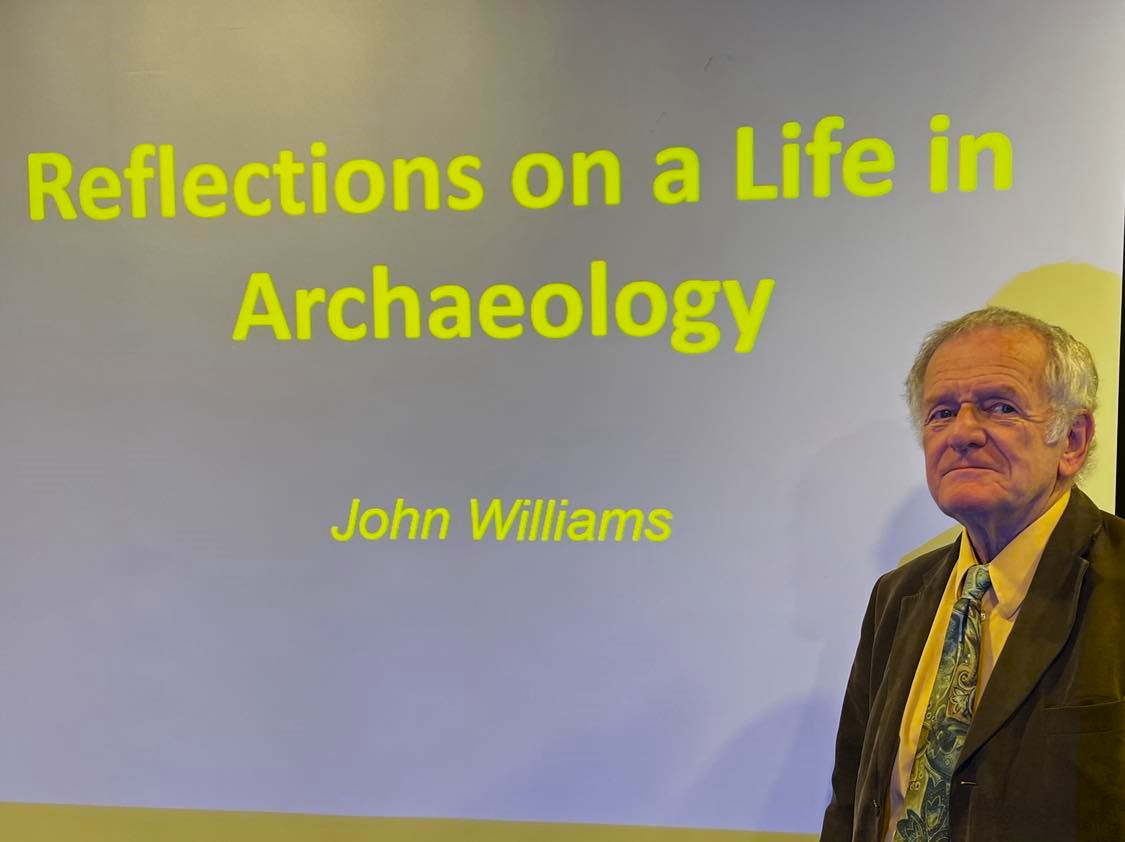
John was formerly County Archaeologist at Kent County Council and is now Chair of the Friends of Canterbury Archaeological Trust.
As a child, he had developed a love for castles, but back in those days pursuing a career in archaeology wasn’t really encouraged. Nevertheless, John wasn’t put off. He wrote for advice to the eminent archaeologist Sir Mortimer Wheeler, well known at the time for his appearances on ‘Animal, Vegetable and Mineral’; Sir Mortimer wrote back, encouraging John to work hard in school and then ‘see what happens”.
Instead of studying archaeology, John went on to read Latin at the University of Manchester but was able in his second year to choose Roman Britain as a specialist subject; immediately following graduation he directed for the then Ministry of Public Building and Works an excavation in Wilderspool, Warrington – the site of a Roman settlement adjacent to the river Mersey. After two years then researching Roman stone building materials, John spent 3 years in the textile industry, gaining valuable management experience, before becoming archaeologist to Northampton Development Corporation, a New Town authority. This was very much at the beginning of the great expansion of archaeological activity in the 1970s in response to the huge development pressure of the time and the recognition that the archaeological heritage needed to be safeguarded or at least investigated in advance of its destruction. John showed us one example of his work at Northampton, the excavation of a large, high-status timber hall dating to the late 8th century. He would return to Northampton at the end of his talk.
At this point John digressed a little to underline the great changes that have taken place in archaeology over the last 50 years: how it is much easier to draw scaled plans in the metric system (base 10) rather than in yards, feet and inches; how computers have greatly speeded recording and organising data; how scientific techniques, including C14 dating, have advanced; and of course how archaeological organisations have increased in number and professionalism during this time.
After 5 years in the late 1980s at Lancaster University, John moved to Kent to become County Archaeologist, the first such post in this county, which was the last to have a County Archaeologist. It was a partnership initiative between the County, the Districts and English Heritage. The role is not one of a digging unit but rather to ensure an appropriate response to planning applications that might have an impact on archaeological remains. The County Archaeologist, working with the local authorities would set the specifications and monitor the work, which would be undertaken by specialist archaeological excavation units such as the Canterbury Archaeological Trust. During John’s time at KCC there were typically between 20,000 and 25,000 planning applications a year, but in his short talk he concentrated on some of the major projects having an impact on buried archaeology.
With some major infrastructure projects there was an opportunity to look more at archaeological landscapes rather than just sites. The Thanet Way 7a road scheme involved the complete stripping of a ‘corridor’ 3km x 30m. Among the remains discovered was a Romano-British village with sunken-featured buildings rarely found outside Kent. Responding to the Channel Tunnel Rail Link consumed a lot of time over a period of more than a decade. An example of work in advance of its construction was that on the Romano-British villa overlying a late Iron Age farmstead, at Thurnham, just north of Maidstone. Another major response was needed for the major expansion of Ashford. John talked through large-scale excavations at the Romano-British roadside settlement at Westhawk Farm and also the multi-period site at Brisley Farm – an interesting aspect here was the way that Bronze Age field systems on the two sites, though some distance apart, followed the same orientation, perhaps indicating large-scale organisation of the landscape.
Besides ‘planning archaeology’ there was also work to be done in promoting heritage. For example, the team played an important role in conserving remains of the Oare gunpowder works and Thurnham Castle within country parks. Indeed, defence heritage is important for Kent: in times of peace the county was a conduit for trade and the transmission of ideas but in more unsettled times it was in the front line for the defence of the realm. Aspects of Kent’s defence heritage were perhaps being underpromoted and in addition to local initiatives John worked in partnership with Kent districts and organisations in Nord-Pas de Calais and West Flanders to develop tourism related to historic fortifications. ‘Walking the Walls’ provides a series of walks in the three regions while ‘Front Line Kent’ by Victor Smith gives a most interesting oversight on the development of Kent’s fortifications over the last half millennium. They can both still be picked up relatively cheaply on the web.
More European cooperation (and European funding) came through the Planarch project, with major heritage partners in Belgium, France, the Netherlands, the Rhineland and Essex. The project aimed in particular to improve the quality of dealing with archaeology in spatial planning and a notable achievement was the launch in the European Parliament building of some Guiding Principles for dealing with the Cultural Heritage in Environmental Impact Assessments.
Finally John, perhaps anticipating the most frequently asked question – ‘What was your best find?’, showed us the remains of a ‘mortar-mixer’ at Northampton dating to the 9th century. What the archaeologists found was a circular bowl, about 2 metres across, cut into the ground and filled with solidified mortar residues from mixing… But when the remains were discovered it was not immediately clear what they represented. Careful dissection followed, not with the archaeologist’s trowel but with hammer and chisel. Now evidence for about 80 such mixers is known from across Europe and John was able to show us a video of a reconstruction being operated by an Italian archaeologist in Tuscany. It is interesting to note that for all their use of mortar and concrete no such mixers are known to have been used by the Romans, and again there is no evidence for them, either physically or in manuscript sources, in the medieval world.
Following a brief Q&A, a vote of thanks was given by our President Rosemary Doyle.
Picture: John pictured at the start of his talk. Picture credit: Rotary Club of Canterbury.


